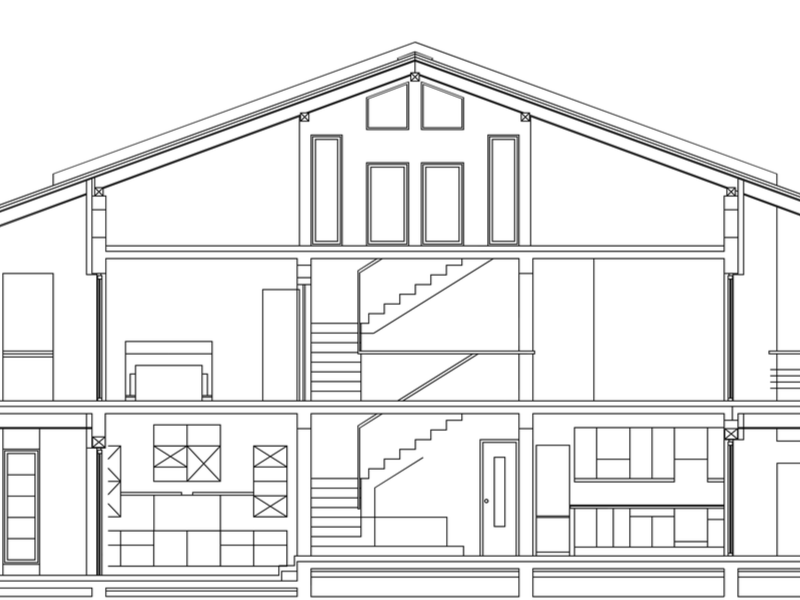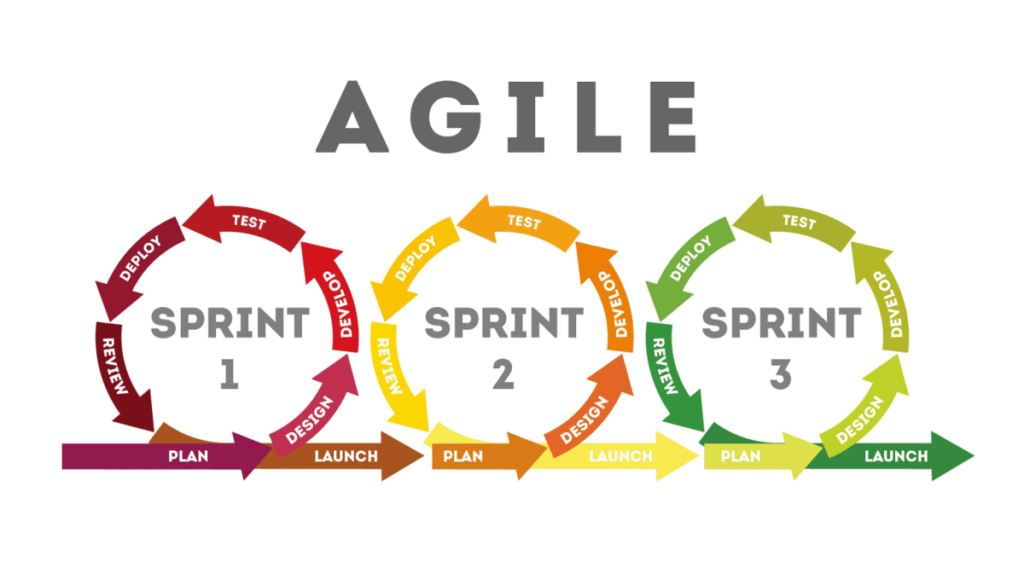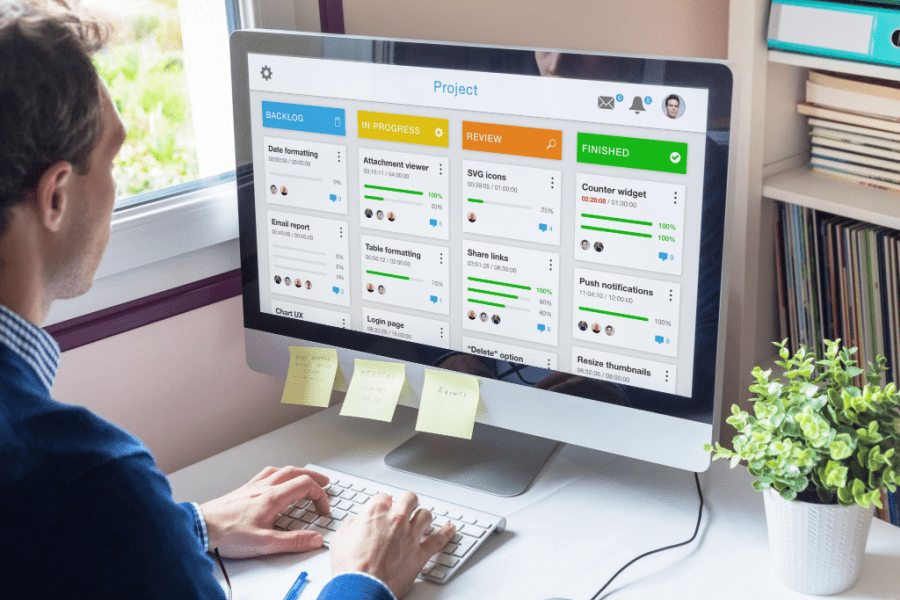When you scroll through your favorite mobile applications on your phone or use business software…
Agile Methodology for Building Applications & App Functionality
 In our first blog post about the Agile Methodology, we defined agile, discussed the roots of the Agile Manifesto, and shared some of the benefits of Agile Methodology for software development.
In our first blog post about the Agile Methodology, we defined agile, discussed the roots of the Agile Manifesto, and shared some of the benefits of Agile Methodology for software development.
In this blog, you’ll find out how building software applications and app functionality using Agile:
- Helps you visualize exactly what your product will look like
- Identifies the RIGHT problem and the RIGHT solution
- Provides a rapid and continuous loop of exploration and feedback to manage changing priorities
- Helps you accelerate delivery of a viable, user-friendly product
- Keeps the budget and timeline intact
You will also see a representation of a non-Agile project flow versus the Agile development process.
“Agile” may seem like a buzzword, but it’s a tangible, practical, and efficient framework to design any type of software product, web application, or mobile app and get it into the hands of the end user much faster.
What is Agile for Software Development?
Before we get into how Agile creates the best possible software development outcome, let’s first define Agile for software development. Agile, in its simplest terms, is frequent, incremental, and iterative improvement of your product while it’s in development and after it’s in the users’ hands. The focus is on enhancing user interface and user experience (UI/UX) by repeated refinement of the application.
The Agile development method values individuals and interactions over processes and tools, working software over comprehensive documentation, customer collaboration over contract negotiation, and responding to change over following the initial plan, especially if the initial plan needs to change.
After adopting Agile, companies have experienced an average 60% growth in revenue and profit. — Zippia
Visualize Your Software Project with Precision
Visual learning statistics show that roughly 65% of people are visual learners, which means they retain visual information with the highest efficiency. That’s nearly two out of three who prefer visual materials in the form of pictures, graphs, charts, and illustrations to learn and retain information. Without visual cues, most people can’t visualize what something looks like until they can see at least part of it, and this is especially true when it comes to technology.
Going back to the house building example we frequently use, at the beginning of the project, it’s difficult to visualize what the individual rooms will look like and how they come together to create a home that is comfortable and easy to get around in. Once we see an initial 3D rendering, we can see what needs to change to fit our desired outcome, then shift and change things as the project unfolds. This is an Agile approach to building a house.
When it comes to software development this same effect is magnified by the fact that most people don’t fully know what goes into a good software interface or what is needed in the backend to make everything work together. But when they see a visual blueprint or “wireframe,” the design becomes clear, as do the areas that need adjusting.
Enter Agile Development …
Agile development gets a detailed visual plan (wireframes) in front of you as quickly as possible. With the first wireframes, you can see what can be done and what needs to be modified before you spend months waiting on the first iteration and blowing the budget, only to find out it’s not going to work. The initial wireframes are derived from learning, testing, validation, and collaboration with great communication.
After the initial wireframes are presented, adjustments are performed until the software or app framework is exactly right, then development begins in Sprints, which are tangible collections of work used to segment the product into bite-sized chunks and keep the project moving ahead quickly and accurately.
For the greatest functionality, the most exceptional user experience, the most productive team, and control over budget, time, and delivery, Agile development is your solution.
Agile Methodology Helps You …
 Identify the Right Problem and the Right Solution
Identify the Right Problem and the Right Solution
Most business leaders think they know where the problem lies, what needs to be “fixed,” and how they want to fix it. However, only when using a true Agile methodology with discovery and exploration can the perceived problem be addressed. And most often, the perceived problem is not the root problem, which the discovery will uncover.
When building web applications and mobile app functionality, Agile takes a hypothesis and identifies the right problem and the right solution. Using the data and feedback, your Agile development team will help you identify the right problem and the right solution with a high degree of certainty. Your Agile team will also demonstrate which things you can’t do that you thought you could and adjust the goals. The discovery may also prove that you can do something you want to do and do it even better with less effort.
Get a Rapid Feedback Loop to Manage Changing Priorities
After initial discovery feedback and your feedback, your Agile team will modify and massage the software’s user interface, develop the backend interrelationships that need to be established, and quickly send another iteration your way. This continuous loop — feedback, learn, adjust — is also used when customers or users weigh in on what’s working and what’s not working. Agile software development is systematic yet flexible.
Accelerate Delivery of Viable, User-Friendly Software Product
Because the Agile methodology lets us work in Sprints that move the software or mobile app project along with speed and a high degree of certainty that can’t be achieved without Agile, you’ll get your new business process automation (BPA) or custom software application in the hands of users much faster, reducing costs, manual labor hours, and potential downtime, which reduce business risk. The Agile feedback system and metrics-driven process also provide you with a highly tested product that gets to market faster and recovers your investment sooner.
Agile at its core is an iterative feedback loop that allows …
- Identification of the RIGHT problem and the RIGHT solution
- Understanding of additional problems that need to be addressed
- A high degree of exploration
- A high degree of certainty in the project’s development
- Gradual Sprints of development with regular communication
- Flexibility: continual adjustment and momentum toward a finished product with excellent UI/UX
- Budget alignment without wasted capital
- Acceleration of delivery to market or internal business implementation
Agile Development Keeps the Budget Intact
Since Agile development improves project accuracy and efficiency, decreases project hours, and provides a better sense of total costs early on, you can narrow project uncertainty earlier, and keep scope creep from taking over.
You will know sooner rather than later before the budget is blown if your custom software or mobile app idea is going to fix the problem and/or bring in revenue, whether it will add value and succeed, and if not, abandon ideas much sooner to keep your budget intact.
Adopting Agile will give you better control over the trajectory of the project itself, timeline, budget, and outcome.
When fully adopting Agile, companies have experienced an average 60% growth in revenue and profit. — Zippia
Let’s look at an example of Agile methodology for building software applications and app functionality versus older development methodologies …
Older development methodologies, such as Waterfall, would look something like this:
- Specs are developed that outline every detail of every page in a web app or mobile app and compiled into a six-inch binder.
- The binder is handed off to the development team.
- The development team goes into a vacuum for six months and codes the specs in the binder.
- Version 1.0 of the web app or mobile app is brought to the creator of the specs.
- Version 1.0 turns out to be incorrectly developed because the business needs have changed in the six-month period and the original spec was never updated.
- The spec creator documents all the changes that need to be made to the application.
- The development team is tasked with going back and refactoring (changing) the web app or mobile app to meet the new specs.
- The development team encounters all kinds of challenges and difficulties in refactoring the app.
- The development team makes changes to one part of the web app or mobile app that breaks other portions of the app and causes those areas of the app to have to be refactored.
- … and the above cycle continues.
- You don’t have a solid grip on what’s going on with your software project.
- The timeline is blown.
- The budget is blown.
- You AND the developers are unhappy and stressed out.
On the contrary, Agile uses the following approach:
- A Minimum Viable Product (MVP) is established to determine the initial set of features to be delivered to the end user.
- A visual set of wireframes of the MVP is created using an online tool to design and begin discussions about the web or mobile app.
- The wireframes are easily modified, moved around, changed, and enhanced to create the optimal workflow through the application.
- You take the wireframes to end users and solicit input on changes.
- The wireframes are updated to contain the changes.
- The changes are verified by the users again.
- The MVP is revisited to make sure it is still on course.
- Only when the wireframes are finalized and established does development begin.
- Sprints, which are tangible collections of work, are used to segment the product into bite-sized chunks.
- The development team goes into action and begins working on Sprint 1.
- Once Sprint 1 has some output, it is given to you for immediate feedback.
- The feedback is evaluated, and Sprint 1 is modified for the changes.
- Development for Sprint 1 is completed and given to you to test with your end users.
- The developer tests Sprint 1 WITH you and end users.
- The developer takes the feedback and implements the tweaks and changes.
- The final Sprint 1 is given to you for further end-user testing.
- While finalizing testing on Sprint 1, the developers proceed to Sprint 2.
- All remaining Sprints are completed using the same process above.
- The final testing on the product is completed.
- A go-live date is set.
- The timeline is maintained.
- The budget is on track.
- You AND the developers are happy and not stressed out.
Agile teams are 25% more productive and 50% faster to market than non-Agile teams. – Zippia
The Bottom Line … Adopt Agile Software Development for a Successful User Experience & the Greatest Business Value
There’s a reason 71% of US companies in the private sector use Agile methodology — the benefits of Agile for building custom software applications and mobile app functionality are many. From less work, less waste, and improved efficiency and accuracy to reduced risk, accelerated delivery, and superior ROI, Agile provides a dynamic product that evolves with your end users’ changing needs, and in the case of business processes, improves internal and remote workers’ communication and outcomes.
Therefore, for the most successful customer and user experience, heightened productivity, and business value, adopt Agile for your next business process automation software development project or for the mobile app you’ve been dreaming of creating.
Swip Systems is Your Agile Software Development Team
If you have been contemplating building a custom software application or a mobile app, you’ve started a project that’s stalled, or to simply learn more about Agile and how it could work with your software or mobile app idea, contact Swip Systems today. There is no obligation — we love to help businesses become profitable with the latest technology. 877.377.SWIP









